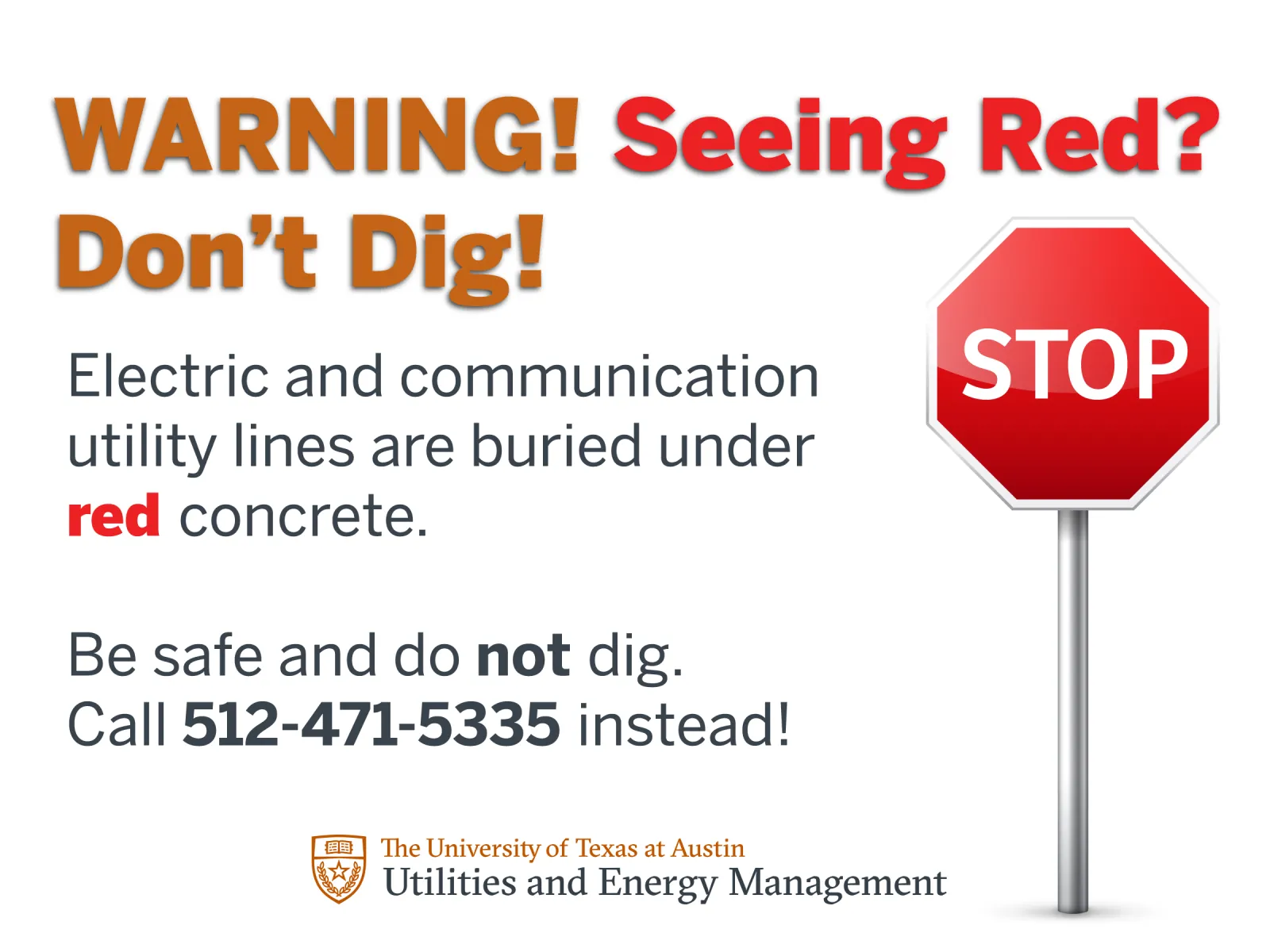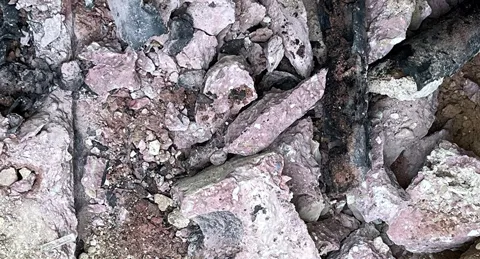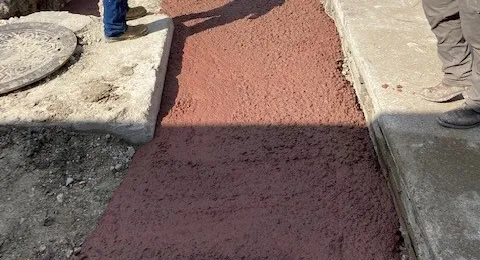What is UT Dig Safe?
Are you planning to excavate on the UT campus or tap a UT underground utility? The UT DIG SAFE program can help identify utility lines before you dig. Knowing what’s below protects both you and our underground utilities. It’s also the law.
To protect lives, property and critical infrastructure, and to ensure proper connections and to avoid cross connections, an Excavation / Utility Tap Permit is required before performing any work on University of Texas (UT) property that involves excavation, trenching, augering or drilling (including soil borings). This permit is also required for any underground work involving a connection to, or modification of, any underground electrical, telecommunications or fluid utility system.
UT is a member of the Texas Excavation Safety System, Inc. (TESS). To perform any excavation on UT property, both UT and TESS procedures, as outlined herein, must be followed. UT will utilize a third-party locator to locate and mark the UT-owned utilities in the immediate area of the proposed excavation. The requestor will be responsible for all costs associated with the third-party locating services. UT TRecs Location Information Services will provide a composite Utility Map of the proposed work area and TESS will locate and mark the public utilities in the immediate area of the proposed excavation. While UT attempts to maintain reasonably accurate Utility Maps, the accuracy of these maps cannot be guaranteed.
Safety Warning
Red concrete is poured over electrical and communication utility lines. This concrete serves as a warning to stop digging. Continuing to dig could create serious safety hazards.
The Emergency Contact Guide for Unexpected Excavation Finds is available if electrical, plumbing, or other unexpected finds arise while excavating.

Red Concrete Examples
Red concrete may look different over time after it dries and is buried. Always check utility line maps and practice caution. Below are some examples of how red concrete can appear.


Before any excavation, trenching or boring occurs on university property, and well before any connections to UT utility systems are made, the following procedures for excavations and utility taps must be observed:
Quick Links
- Our Services
- Excavation/Utility Tap Permit Application
- Emergency Contact Guide for Unexpected Excavation Finds
Questions
Have questions about UT Dig Safe or need help filling out the Excavation/Utility Tap Permit Application? E-mail us at UTDigSafe@austin.utexas.edu.
Procedures for Excavations
Submit a Request
An excavator must submit an Excavation Permit Request when moving earth by the use of motorized equipment to any depth or when hand excavating to a depth of more than 16 inches.
File a Request & Drawings
A completed Excavation Permit Request, along with project drawings showing the limits of excavation and the utility tie-in locations, must be filed with the Utilities and Energy Management Department (UEM) at least two full working days (48 hours – weekends and holidays excluded) prior to the start of work to ensure adequate time to issue the permit but, no earlier than the 14th day before the excavation is to begin.The request form should be emailed to UTDigSafe@austin.utexas.edu.
- The Excavation Permit Request will be reviewed for potential conflicts by the following UT departments within 48 hours of receipt of the Excavation Permit Request or a time agreed by the excavator and UEM:
- Utilities and Energy Management
- Information Technology Services (ITS)
- Campus Planning and Construction (CPC)
- Project Management and Construction Services (PMCS)
- Environmental Health and Safety (EHS)
- Parking and Transportation Services (PTS)
- Facilities Services’ Landscape Services and Urban Forestry
Notify One Call
In accordance with Texas Utilities Code Title 5, Chapter 251, UNDERGROUND FACILITY DAMAGE PREVENTION AND SAFETY, and Texas Administrative Code (TAC) Title 16, Part 1, Chapter 18, UNDERGROUND PIPELINE DAMAGE PREVENTION, the contractor shall call One Call by dialing 811 or calling 1-800-DIG-TESS at least 48 hours prior to excavation (weekends and holidays excluded). Special care shall be taken when excavating around any utilities but, in particular those containing energy sources that may present a hazardous condition including, but not limited to, natural gas, electricity, steam, chilled water, heating hot water and domestic water. When digging within 3 feet of a known or suspected existing utility, discontinue use of heavy, motorized equipment including backhoes or excavators and begin potholing and/or hand-digging until the utility is located.
Identify all Activities
All boring, augering and drilling activities shall be identified at the time of permit request and reviewed with UEM prior to commencement of the work. Special care shall be taken to ensure that all known, existing utility locations are verified. Boring, augering and drilling shall not occur within 6 feet of any marked utility without approval from UEM.
Assume All Risks
Failure to follow the Excavation Permit Procedures may result in damage to utilities and adjacent properties, personnel injuries and/or fatalities and the loss of privilege to work on Campus. By excavating on the University of Texas at Austin campus, the Contractor assumes all risk of injury, property damage and liability for all costs associated with any service interruption and restoration, as well as for any claims, demands, actions, causes of actions, damages or judgments arising out of personnel injuries or property damage resulting from the excavation.
Contact Your UT Project Manager
Extreme care shall be taken to protect, support and guard exposed utilities to prevent any damage or disturbance. Contact your UT Project Manager and UEM in all cases where utilities will require such care.
Maintain a Signed Permit
A copy of the signed excavation permit, the utility map and the project design documents must be maintained at the project site at all times. If requested, these documents must be presented to UT personnel.
Call a Utility Location Service
An excavation permit is valid for fourteen (14) days including the day of issue. The requesting party shall be responsible for calling a utility location service and for maintaining the locate marks. Please remember, that in some instances traffic, rain or other weather conditions may result in marks being lost or diminished. If the excavation project is not completed at the time the excavation permit expires, the permit must be renewed by submitting an updated excavation permit. The request to renew the permit shall be limited to the area yet to be excavated. Requests for renewals of existing permits must be requested a minimum of seven (7) days prior to expiration.
Provide As-Built Drawings
When a project has been completed, as-built drawings must be provided to :Kenny Cajas, Lead Utility System Programmer, 215 E. 24th Street, room 2.302F, (512) 471-1741. All electronic correspondence should be addressed to TRecs Location Information Services at LIS@austin.utexas.edu.
Procedures for Utility Taps
Submit an Outage Request
Connecting to an existing UT utility distribution system requires advanced coordination with, and a written Outage Request to, the appropriate Utilities and Energy Management (UEM) division at least seven working days prior to the proposed tie-in date. Some utility outages require months of advanced preparation. Depending on the effect of the proposed outage, the outage request may be delayed. Utility outages should be coordinated through the project’s UT Project Manager. UEM will execute all outages by isolating and de-energizing the related energy sources and implementing lock-out-tag-out protocols in parallel with the requestor’s lock-out-tag-out devices.
Perform Inspections
To ensure that underground utility systems are installed according to the project specifications, the project construction inspectors should perform all of the contractually-required inspections during the course of installation. In parallel, UEM staff shall be coordinated to perform specific inspections of underground utility systems as determined through the Excavation / Utility Tap Permitting process. Inspections by UEM do not relieve the project team of the responsibility for providing the installation required by the contract documents.
Complete UEM Inspections
Each utility type, construction method and material type has unique requirements that will be inspected by UEM staff before the project can move to the next construction phase. Under no circumstances should a utility trench be backfilled before UEM has performed all of the inspections listed on the project Excavation / Utility Tap Permit. Any backfill that is placed before all of the UEM inspections are complete will be required to be removed at the contractor’s expense so that the inspections can be performed.
Coordinate a Service Request
If a meter is required from one of the public utility providers, the UT Project Manager should contact the appropriate UEM department to coordinate the request for service, the proper establishment of an account, and the procurement of a meter. The project that requires the meter will be responsible for all costs associated with obtaining service. UEM will provide assistance coordinating with the utility provider. This process should begin at the very outset of the construction at NTP because of the long lead times associated with procurement, especially in the case of water meters from the City of Austin.
